Why Referral Campaigns are the Future of Marketing
Referral marketing is becoming the future of marketing, and for good reason. In today’s digital landscape, consumers are bombarded with advertisements and are becoming increasingly resistant to traditional marketing tactics. However, referrals provide higher quality leads than any other online channels. In this blog post, we will explore the benefits of referral marketing, how it complements and improves other digital marketing strategies, and why using affordable no-code referral software is the best option. We will also provide basic steps to create a referral program and list the top 5 referral software to use. So, let’s dive in and discover why referral campaigns are the future of marketing.
What is Referral Marketing?
Referral marketing is a strategy that taps into the power of word-of-mouth recommendations. It involves incentivizing existing customers to advocate for your brand and refer their friends and family to purchase from you. Referral campaigns can take many forms, such as offering discounts or rewards to customers for referring others, or creating a referral program that rewards advocates for their efforts. Referral campaigns rely on the power of word of mouth to drive new business, as people are more likely to trust recommendations from friends and family than traditional advertising. By leveraging the power of referrals, businesses can attract high-quality leads and increase customer loyalty.
Enter your website below to create a referral campaign for your brand in just one click
Table of Contents
The Benefits of Referral Marketing
Referral marketing has proven to be a powerful tool for businesses in recent years. Studies show that referral campaigns offer increased conversion rates, lower customer acquisition costs and higher customer lifetime value. By tapping into the advocacy of satisfied customers and their networks, brands can reach new audiences with less investment while simultaneously boosting their reputation.
Why Referred Friends are High Quality Leads
Referred customers are 4 times more likely to make a purchase and have a 16% higher lifetime value, making referral marketing an effective strategy for increasing brand advocacy.
— Referral Factory
Referred customers have a higher likelihood of making a purchase compared to other leads. This is because they already trust the brand due to the recommendation from someone they know and trust. Referrers also tend to refer people with similar interests and needs, leading to more targeted leads. These referrals are not only more likely to make a purchase, but also tend to be more satisfied with their experience.
Why Referrals Increase Customer Retention Rate
Referred customers also tend to be more loyal and stay longer than other types of customers. They become advocates for the brand, recommending it to their network which increases awareness through word-of-mouth marketing. By implementing referral campaigns, brands can tap into this powerful tool that not only generates high-quality leads but also increases brand loyalty and advocacy in an affordable way without having expensive contests or promotions as incentives for your referrers or prospects.
In fact, research shows that customers acquired through referrals have a 37% higher retention rate than those acquired through other channels.
Why Referrals Save You Money
Referral marketing stands out as a cost-effective strategy compared to traditional advertising methods. Traditional marketing campaigns often require substantial investments in advertising budgets, such as print ads, TV commercials, or digital banner ads. In contrast, a successful referral program taps into the power of customer advocacy, leveraging existing customer relationships to generate new leads. Numerous studies and statistics highlight the impressive return on investment (ROI) of referral marketing campaigns.
Referred customers have a 16% higher lifetime value than non-referred customers and referred customers had a 25% higher profit margin compared to customers acquired through other means.
— Referral Factory
Why Referral Campaigns are the Future of Marketing
The Return on Digital Advertising Spend Will Continue to Decline
Ad fatigue and competition are driving up costs for digital advertising. Consumers are becoming more immune to traditional ads, which is causing a shift towards using ad-blockers, thus reducing the reach of digital advertising. This decline in return on investment (ROI) has led marketers to look for alternative ways to connect with their target audience.
According to a study conducted by the Interactive Advertising Bureau (IAB) and PwC, the return on digital advertising spend has been showing a decline. The research indicates that the average return on ad spend (ROAS) for digital advertising campaigns dropped by 12% between 2017 and 2019. This suggests that businesses are experiencing diminishing returns on their digital advertising investments, highlighting the need for alternative strategies such as referral marketing to maximize marketing effectiveness.
New Consumer Protections Will Increasingly Limit Paid Advertising
In today’s digital landscape, the future of marketing is rapidly evolving, and referral campaigns are emerging as a powerful force. One of the key factors driving this shift is the implementation of new consumer protections that limit cookies and tracking. While these measures aim to enhance user privacy and data security, they also have a significant impact on the targeting potential of pay-per-click (PPC) advertising. With stricter regulations and limitations on tracking, businesses face challenges in reaching their desired audience with personalized and targeted ads. Referral campaigns, on the other hand, rely on organic word-of-mouth recommendations and bypass the need for intrusive tracking methods, allowing brands to connect with potential customers in a more authentic and trusted way. As consumer preferences continue to prioritize privacy and control over their online experiences, referral campaigns offer a future-proof solution that respects these concerns while driving effective marketing results.
Referral Marketing, on the other hand, is naturally well targeted. Existing customers are a valuable resource when it comes to targeting potential leads through referral campaigns. They already have an understanding of who would be interested in your product or service, and tend to refer to people with similar needs and interests as themselves. When someone refers a friend or family member, they’re doing so with intent — knowing that person has expressed interest or has a need for what you offer. This makes referral campaigns naturally well-targeted and more likely to result in conversions than traditional digital advertising methods, which can often feel like throwing money at the wall and hoping something sticks.
Consumer Acceptance of Referral Marketing Is Growing
Word-of-mouth has long been recognized as a powerful marketing tool, with people naturally sharing their positive experiences with others. While the concept of referral marketing is not new, consumers today are more aware than ever of its significance and actively engage in it. In the age of social media and online communities, individuals have a broader reach and greater influence, making their recommendations and opinions more impactful. With the rise of referral software and the ease of sharing experiences online, consumers understand the value of referral marketing in making informed purchasing decisions. As consumers continue to seek authentic and trustworthy information, the power of referrals will only grow stronger, shaping the future of marketing.
The kind of referral marketing that we know today, began to take hold in the 2000s, with tech giants like Dropbox and Paypal launching strong customer referral programs. PayPal, for example, gave cash incentives to users who recommended new members to register for the online payment platform. This campaign played a crucial role in propelling PayPal’s quick expansion and eventual acquisition by eBay in 2002. Similarly, in 2008, Dropbox introduced a referral program that granted users extra storage space when they referred their friends to join the service. This initiative was highly effective, enabling Dropbox to increase its user base from 100,000 to over 4 million within a span of 15 months. Almost 20 years later, consumers are not only familiar with the concept of referral marketing, they also prefer it over traditional paid advertising.
71% of consumers prefer to find brands or services themselves, via friend’s recommendations, browsing in-store or online searches, showing that consumers have a marked decrease in trust for traditional advertising.
— Marketing Week
Referral Campaigns can be Automated and It Will Only Get Better
Referral program software can handle almost all aspects of a campaign, automating the process and reducing workload while making tracking easier. The automation also allows for more precise targeting with personalized messaging, leading to higher conversion rates. Additionally, the data collected from an automated referral program provides valuable insight for future marketing decisions by providing information on what works best to acquire new customers through word-of-mouth referrals. With these benefits in mind, it’s clear that highly automated referral campaigns are the way forward for businesses looking to improve their marketing strategies and increase conversions.
Given the rapid increase in technology in the past 6 months alone, the possibilities for automation are already showing exciting potential. Referral Factory, for example, recently launched an AI-powered referral program generator, which pulls the branding and tone from a company’s website and automatically generates a referral program, meaning that you can go and generate multiple referral program ideas at the click of a button.
Referral Marketing Software Can be Seamlessly Integrated with Other Digital Marketing Tools
In recent years, our perception of software has evolved significantly. Previously, software was typically seen as autonomous programs designed to perform a specific set of related functions, operating in isolation from other applications. However, with the advent of Software-as-a-Service (SaaS), we have witnessed a fundamental shift towards interconnectedness and integration. Modern SaaS platforms offer the ability to seamlessly link up various software solutions, enabling businesses to create comprehensive ecosystems where different tools and functionalities can interact and share data, fostering collaboration, efficiency, and improved user experiences.
Integrating your existing digital marketing stack with referral software enables a more cohesive and streamlined customer experience. Referral data can be synced to email marketing platforms, meaning that businesses can automate referral-related email communications, ensuring consistent messaging and personalized follow-ups. Moreover, by integrating with CRM platforms like HubSpot, Zoho and Salesforce, means that successful referrals can be captured via status changes in sales pipelines, making conversion tracking and automated rewarding super easy. Further, integration allows businesses to gain deeper insights into their referral program’s impact on customer acquisition and retention, enabling them to nurture and build stronger relationships with referred customers.
Building a Referral Program
Enter your website below to see how using a plug-and-play referral software can help you build a referral program in seconds
A referral campaign can be a powerful tool for acquiring new customers and increasing brand awareness. When building your own referral program, you will need to decide whether to use off-the-shelf software or build everything from scratch. While it may seem tempting to create your own program, using no-code referral software is often the most effective and affordable option.
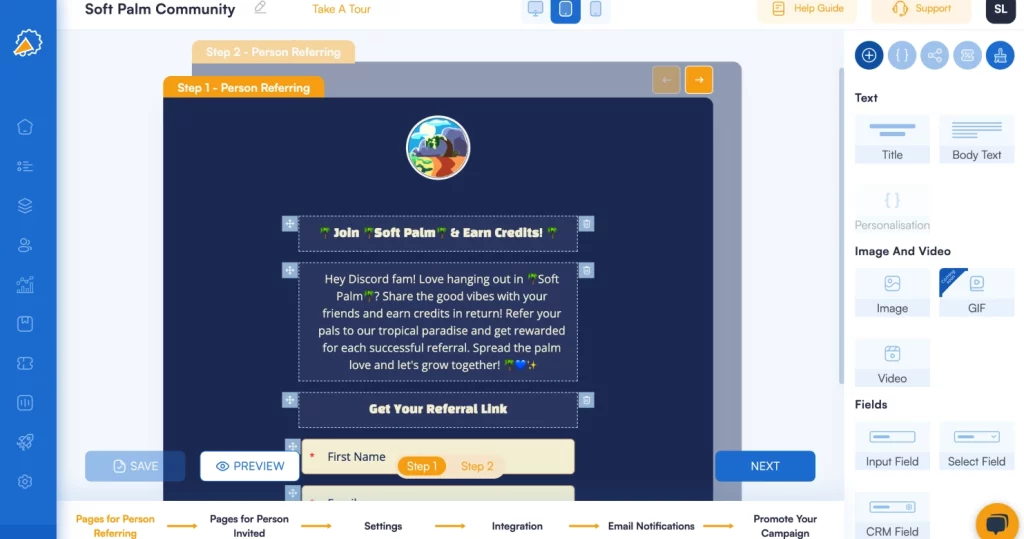
To launch a successful referral campaign, there are several basic steps that you should follow. First, determine what incentives you will offer both the referrer and referee. Next, choose an easy-to-use platform with customizable features that align with your brand image. Finally, promote your program through multiple channels such as social media or email marketing.
When choosing no-code referral software for your business, look for key features such as easy integration with CRMs and other digital marketing software, as well as real-time analytics tracking of referrals’ performance in order to identify areas where improvements can be made quickly while maintaining top-level ROI results over time.
Building Your Own Referral Program vs Using Plug-and-Play Software
Building your own referral program may seem like a cost-effective solution, but it’s important to conduct a thorough cost-benefit analysis. While customization options with self-built programs are limitless, the time and resources required for development and maintenance can quickly outweigh any potential benefits.
Off-the-shelf referral software offers ease and speed of implementation, with many customizable features available at an affordable price point. While some limitations may exist in terms of customization options, the convenience and efficiency that comes with using no-code referral software is often worth it for businesses looking to quickly launch their campaign without sacrificing quality or effectiveness.
Basic Steps to Build a Referral Program
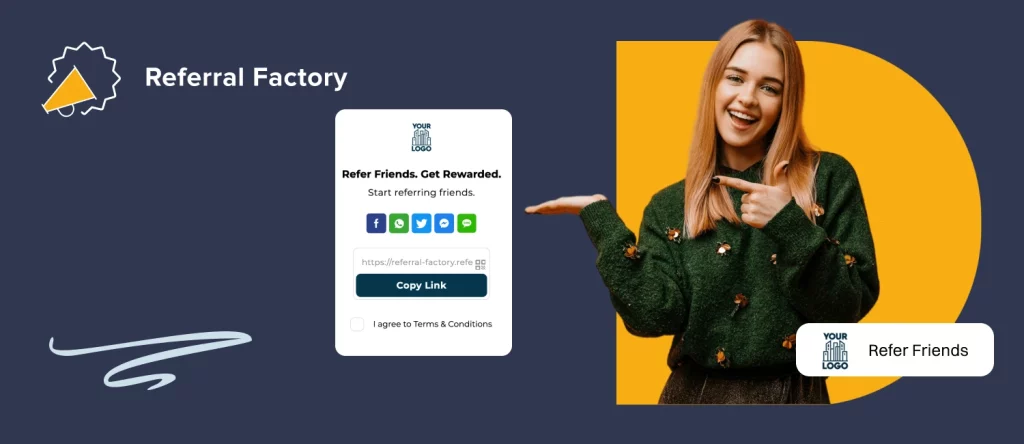
With no-code referral marketing software, you can typically get a referral program up and running in a matter of hours. Here are the basic steps to build a referral program:
Step 1: Set Clear Goals
Start by defining clear and measurable goals for your referral program. Whether it’s increasing customer acquisition, boosting sales, or expanding brand awareness, establishing specific objectives will guide your program’s design and enable you to measure its effectiveness.
Step 2: Identify Your Target Audience
Identify your target audience—the individuals or groups most likely to refer your business. Analyze your existing customer base and identify loyal customers who are satisfied with your offerings. Additionally, consider engaging with industry influencers or collaborating with complementary businesses to widen your referral network.
Step 3: Determine Rewards and Incentives
Decide on the rewards or incentives you will offer both the referrer and the referee. Consider offerings that align with your target audience’s interests, such as discounts, exclusive access, or store credits. Ensure the rewards hold value and are enticing enough to motivate participation.
Step 4: Create a Seamless Referral Process
Simplify the referral process for your customers. Implement user-friendly referral software or tools that make it easy for referrers to share their unique referral links and for referees to redeem their rewards. A seamless process enhances participation and improves the overall user experience.
Step 5: Develop Engaging Messaging and Promotional Materials
Craft compelling messaging and promotional materials to effectively communicate the benefits of your referral program. Highlight the value of your offerings, the rewards, and the positive impact of referrals. Use captivating visuals and persuasive language to engage your audience and generate excitement.
Step 6: Promote Your Referral Program
Utilize various marketing channels to promote your referral program. Leverage your website, social media platforms, email newsletters, and offline marketing materials to spread the word. Encourage existing customers to share their positive experiences and refer others through targeted campaigns and strategic messaging.
Step 7: Track and Measure Results
Implement tracking mechanisms to monitor the performance of your referral program. Utilize referral tracking software or tools to gather data on referrals, conversions, and rewards. Regularly analyze the metrics to identify areas of improvement and optimize your program for maximum effectiveness.
Step 8: Nurture and Reward Advocates
Recognize and appreciate the efforts of your brand advocates. Regularly acknowledge and reward top referrers to maintain their motivation and loyalty. By fostering a positive relationship with your advocates, you create a cycle of continued referrals and sustained growth.
Features to Look for in No-Code Referral Software
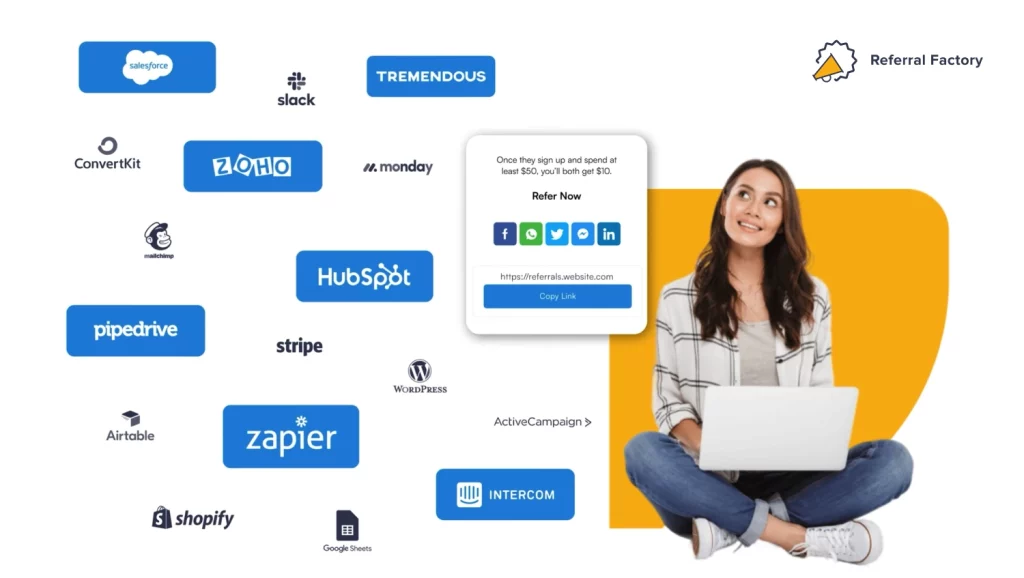
With numerous software options available, it’s crucial to choose a solution that aligns with your specific needs and goals.
1. Easy Referral Tracking:
Look for software that offers seamless referral tracking capabilities. It should provide unique referral links, track conversions, and offer real-time analytics to monitor the performance of your referral program effectively.
2. Automated Reward Management:
Choose software that simplifies reward management. It should automate the process of tracking and delivering rewards to both referrers and referees, ensuring a smooth and efficient experience for all participants.
3. Customizability:
Opt for software that allows you to customize your referral program to suit your brand’s unique requirements. Look for features that enable you to define referral rules, set reward structures, and customize messaging and branding elements.
4. Integration:
Consider software that seamlessly integrates with other software including email marketing tools, CRMs and other digital marketing tools. This enables you to streamline your existing marketing tactics and interface with teams outside of marketing.
5. User-Friendly Interface:
Ensure the software you choose offers an intuitive and user-friendly interface for both you and the people who will refer to their friends.
6. Analytics and Reporting:
Select software that provides robust analytics and reporting features. Detailed insights into referral performance, conversion rates, and customer behavior allow you to optimize your referral program and make data-driven decisions.
7. Scalability and Flexibility:
Consider software that can scale with your business as it grows. It should offer flexibility to accommodate changing referral program requirements, whether you need to expand your rewards, introduce new referral channels, or integrate with other marketing tools.
Real-Life Referral Program Examples
There are so many successful referral marketing campaign examples out there to learn from, of which famous examples are Uber, PayPal, Dropbox and AirBnB. But, there are so many more real-life examples that digital marketers can learn from. Here are a few:
Harry’s Shave Club
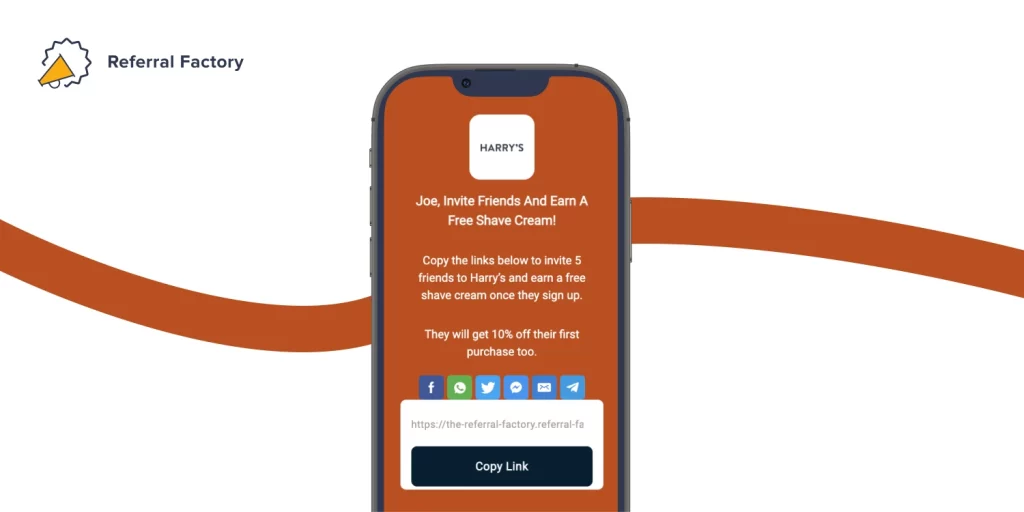
The shaving company Harry’s implemented a clever referral program where customers could refer their friends to receive free shaving products. Harry’s referral program was clever for several reasons. Firstly, the call to action was straightforward and enticing. They encouraged customers to refer their friends in exchange for free shaving products. This clear and simple message made it easy for customers to understand the program and take immediate action.
Secondly, the rewards and incentives offered by Harry’s were highly appealing. By referring friends, customers could earn free shaving products, which held significant value for their target audience. This incentivized existing customers to actively participate in the referral program and motivated them to spread the word about Harry’s.
The results of Harry’s referral program were remarkable. In just one week, they acquired over 100,000 email sign-ups, showcasing the immense success of their program. This influx of new customers translated into substantial revenue growth for the company.
Digital marketers can learn a valuable lesson from Harry’s referral program. Simplicity is key. By keeping the call to action clear and concise, marketers can eliminate confusion and make it easy for customers to understand and participate in the referral program. Avoid overwhelming potential referrers with complex instructions.
Evernote

Evernote’s referral program demonstrated cleverness in its design, compelling call to action, enticing rewards, and notable results. The program encouraged users to refer their friends to the note-taking app. Users who successfully referred others would earn points that could be exchanged for premium upgrades.
This clever approach provided a win-win scenario for both the referrer and referee, as both parties benefited from the referral. The incentive of premium upgrades motivated users to actively participate in the program, resulting in millions of new users acquired by Evernote and a significant expansion of their user base.
What can digital marketers learn from Evernote’s referral program? In most cases, a double-sided referral reward works best! Evernote’s approach rewarded both parties, providing an added incentive for users to refer their friends and for referees to take action. This balanced reward system ensures a win-win situation and encourages higher participation rates.
The Hustle
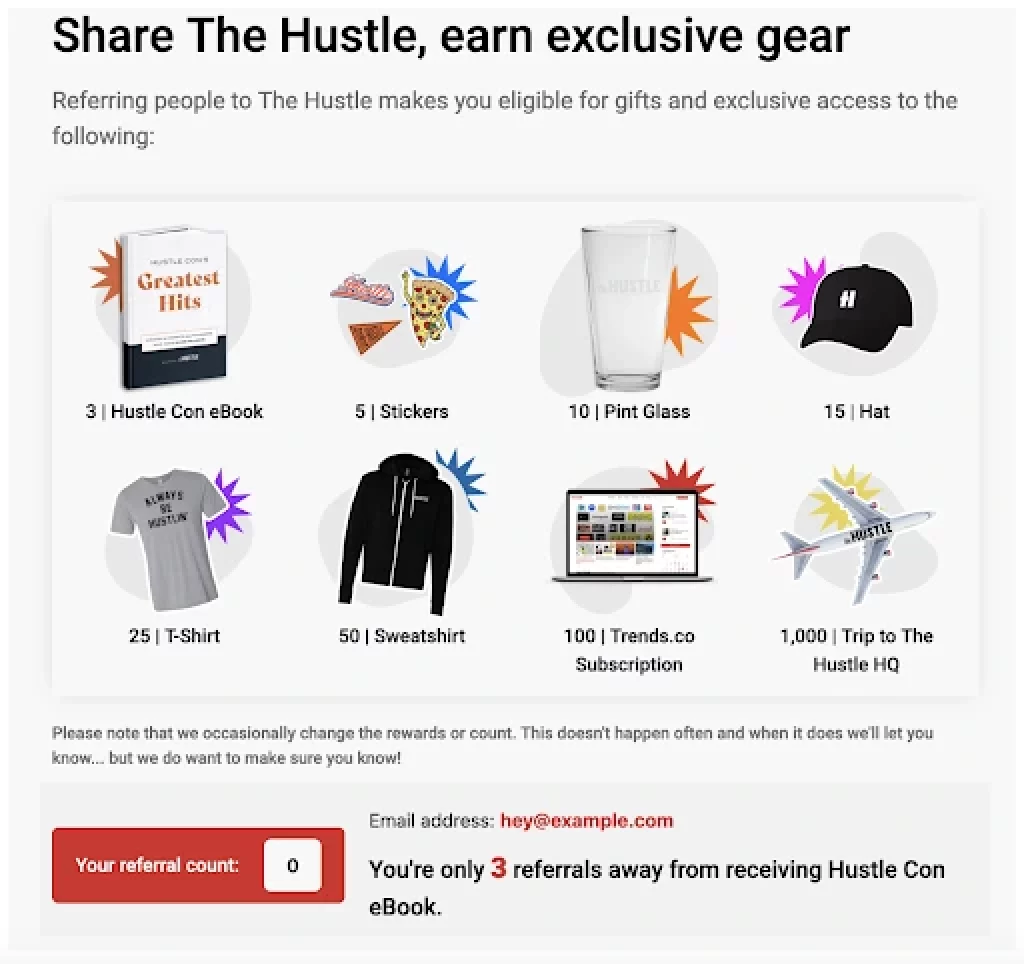
The Hustle’s referral program showcased cleverness through its unique “Give $1, Get $1” approach. The program encouraged users to refer their friends to sign up for The Hustle’s newsletter. For each successful referral, both the referrer and the referred friend received $1. This creative incentive structure created a mutually beneficial arrangement, where both parties were rewarded for their participation. The program’s cleverness was reflected in its simplicity and the immediate gratification it provided to users.
One tip that digital marketers can learn from The Hustle’s referral program is to incorporate immediate rewards or incentives into their referral programs. By offering instant gratification, you can motivate users to take immediate action and refer others. Whether it’s monetary rewards, discounts, freebies, or exclusive access, providing immediate incentives creates a sense of excitement and encourages users to actively participate in the referral program. The element of instant gratification can help drive engagement, increase referral rates, and generate positive results for your business.
Dollar Shave Club
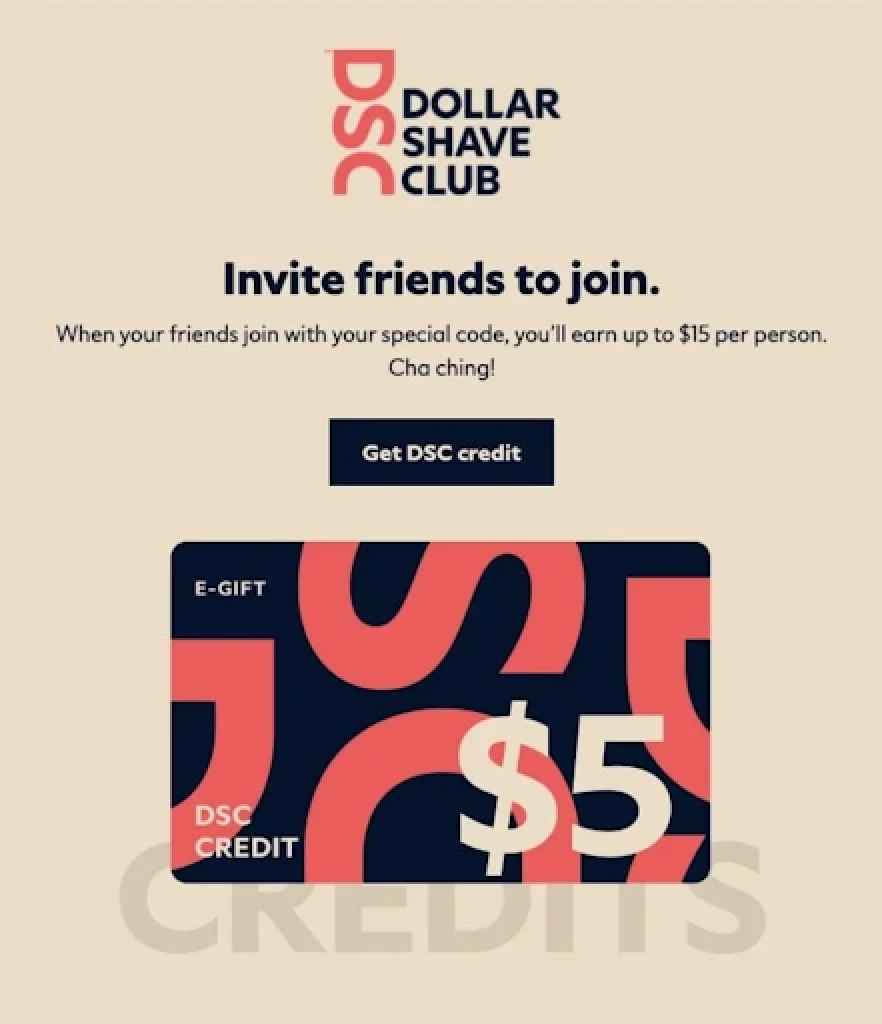
Dollar Shave Club’s referral program showcased cleverness through its combination of humor, compelling call to action, and enticing rewards. The program encouraged existing members to refer their friends to join the subscription-based razor service. For each successful referral, the referrer would earn a free month of razors. The program’s cleverness was further enhanced by Dollar Shave Club’s humorous marketing campaigns, which added an element of fun and engagement to the referral process.
The results of Dollar Shave Club’s referral program were remarkable. The program played a significant role in their explosive growth, with millions of subscribers acquired. Eventually, the company was acquired by Unilever for a staggering $1 billion, further highlighting the success of their referral program.
A tactic that digital marketers can learn from Dollar Shave Club’s referral program is to leverage humor and creativity to make the referral process more engaging and shareable. By infusing humor into your marketing campaigns and referral program, you can capture the attention of your audience, increase their willingness to participate, and make the referral experience enjoyable. Humor has the power to create a memorable and shareable experience, increasing the chances of your referral program gaining traction and driving successful results.
These real-life examples demonstrate the effectiveness of creative referral marketing ideas in driving customer acquisition and business growth. Each company successfully leveraged unique incentives, engaging campaigns, and seamless referral tracking to generate significant results in terms of user sign-ups, revenue, and overall brand success.
Top 5 Referral Software to Use (Based on Reviews)
When it comes to running successful referral campaigns, choosing the right software is crucial. Our team scoured through customer reviews and feedback to provide you with a comprehensive overview of the top referral software in the market.
1. Referral Factory
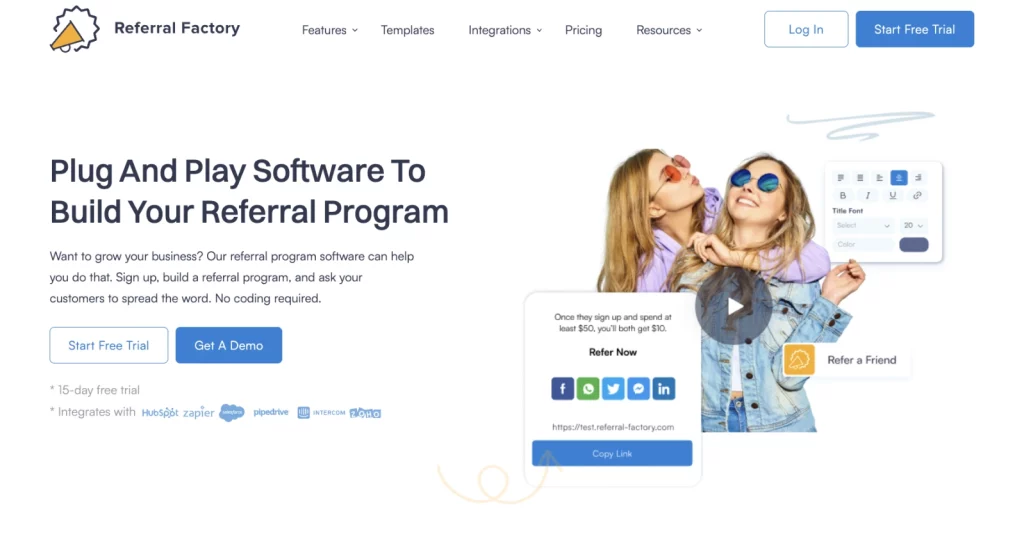
Rated as the ‘best’ and ‘most simple’ on multiple review sites, Referral Factory offers easy-to-use referral program software for businesses. With access to over 100 templates, a campaign builder, email tools, referral tracking tools, referral rewards, and analytics, Referral Factory’s software requires no developers or experience in referral marketing.
2. Refersion
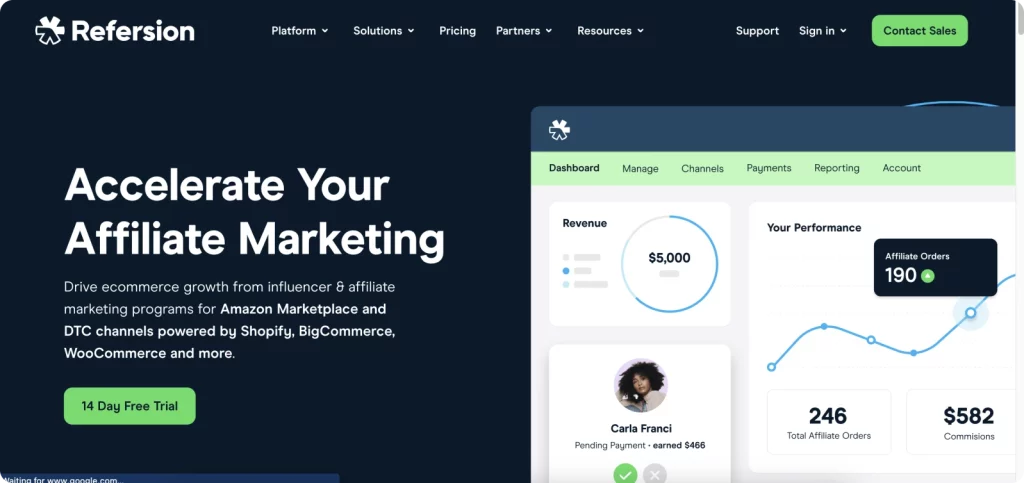
Primarily an affiliate marketing network, Refersion also functions as a referral marketing tool and influencer marketing platform. It can integrate with eCommerce stores and allows for customized and targeted offers with various payment schemes. Their reporting function is focused on sales and provides various data angles.
3. Ambassador
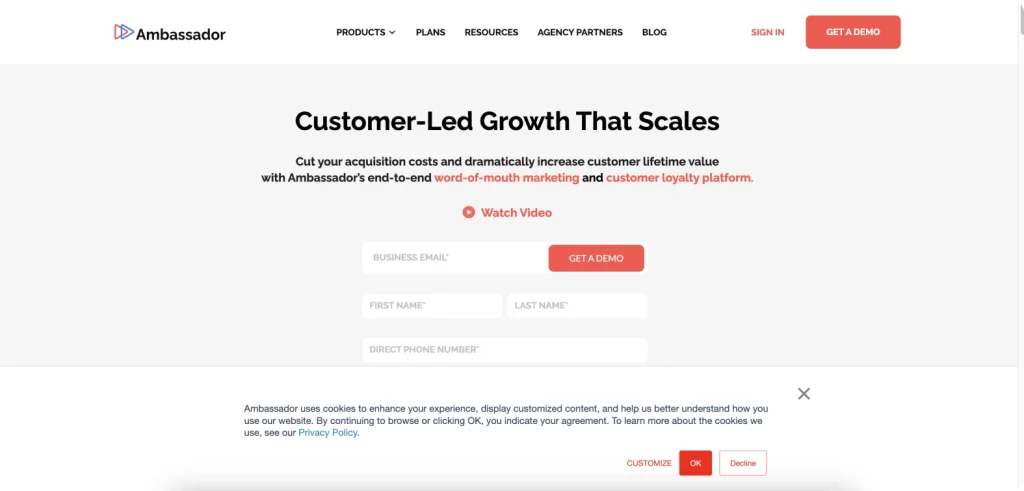
Ambassador provides businesses with a comprehensive referral marketing platform, including referral tracking, sharing, and analytics. The platform is user-friendly and offers customization options for businesses to create their referral program.
4. ReferralCandy
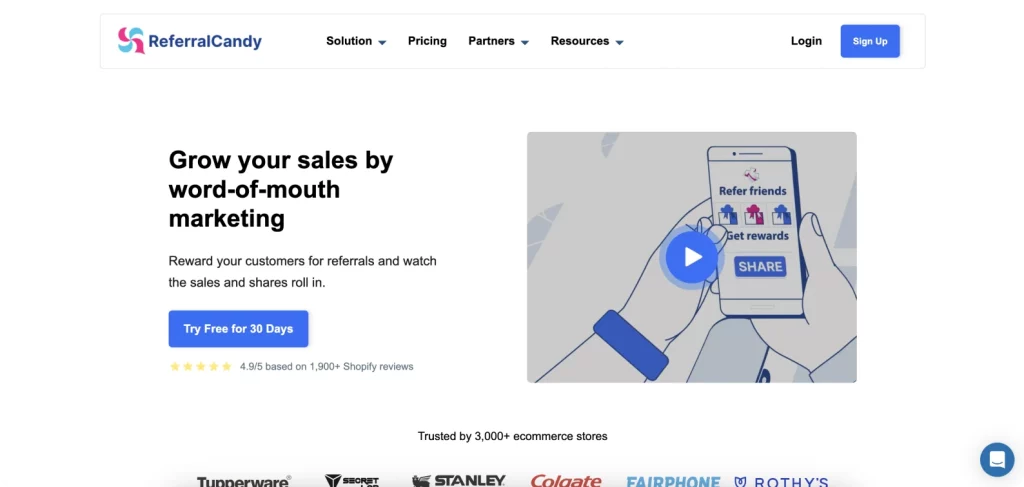
ReferralCandy is referral marketing software that enables businesses to create and manage their own referral program. It offers customizable referral programs, payment schemes, and a dashboard for tracking referrals and rewards.
5. Talkable
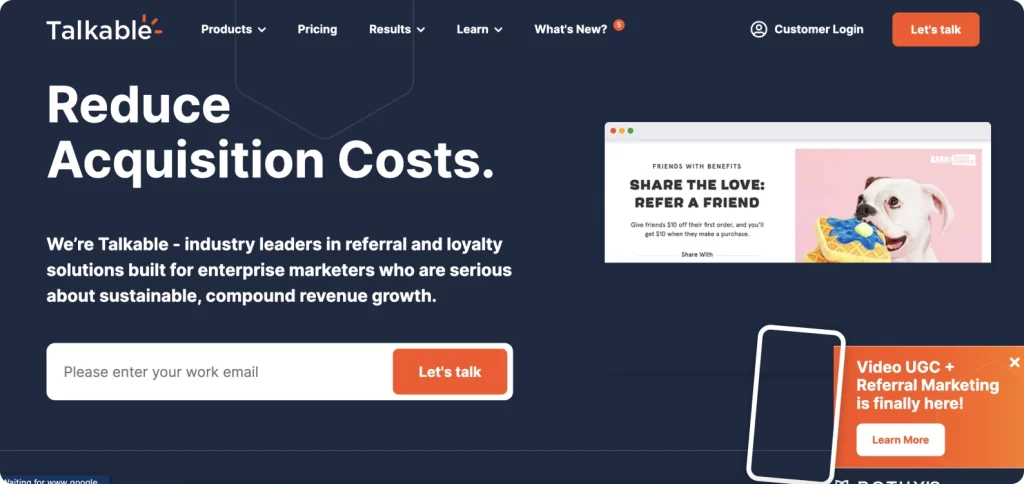
Talkable is a referral marketing software that enables businesses to create personalized referral programs. It offers a range of customization options, including referral rewards, emails, and landing pages.
Bonus: More Predictions for the Future of Digital Marketing
The world of digital marketing has been evolving rapidly over the last decade, and the pace of change is only set to accelerate in the future. One of the most significant trends that we are likely to see is the increased use of AI and software in digital marketing. This technology will allow marketers to personalize their campaigns more effectively and create a more seamless customer experience. For example, AI-powered chatbots can help to answer customer queries immediately, while machine learning algorithms can analyze huge amounts of data to help businesses better understand their customers’ needs and preferences.
Another trend that we are likely to see in the future of digital marketing is the increasing importance of software. As technology continues to advance, businesses will need to keep up with the latest software solutions if they want to stay competitive. From content management systems to marketing automation platforms, there is a wide range of software tools available that can help businesses to streamline their marketing efforts and achieve better results. However, it’s important for businesses to stay up-to-date with the latest developments in this area and ensure they are investing in the right tools for their needs.
Overall, the future of digital marketing is exciting and full of potential. As AI and software become more prevalent in this field, businesses will be able to create more personalized and engaging experiences for their customers. However, it’s important for companies to keep up with the latest trends and invest in the right technology solutions if they want to succeed in this fast-paced and ever-changing industry. By staying ahead of the curve and embracing new technologies, businesses can position themselves for success in the years to come.




